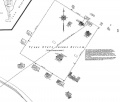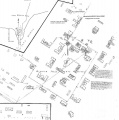Wichita Falls State Hospital
| Wichita Falls State Hospital | |
|---|---|
 | |
| Established | 1917 |
| Opened | 1922 |
| Current Status | Active |
| Building Style | Cottage Plan |
| Location | Wichita Falls, TX |
| Peak Patient Population | 3,481 in 1955 |
| Alternate Names |
|
History[edit]
In 1917, the State of Texas created the Northwest Texas Insane Asylum. It was located on 940 acres seven miles south of Wichita Falls. The first patient was admitted to this new facility in 1922. In 1925, the name was changed to Wichita Falls State Hospital (WFSH). It had a modern surgical operating room, radiology, laboratory, electrotherapy apparatus, and hydrotherapy equipment. By 1930, the census was over 1500 patients with a staff of 235, including seven doctors and 93 attendants. During the height of the Depression, the hospital was virtually a self-sustaining community. It had an agricultural enterprise that included farming, hogs, chickens, and cattle. Most of the staff lived on the campus.
By World War II, the hospital consisted of 35 brick buildings and 60 frame structures. Due to wartime shortage of available employees, 234 staff members served approximately 2400 patients. Staff worked six days per week, 12 hours per day. Six nurses rotated coverage at night; three staff members offered occupational therapy. The end of the war saw the total number of employees rise to 503 by the early 1950's. In 1951, Vernon State Home was activated as a branch of WFSH at the old Victory Field Army Air Corps training field. Vernon served about 400 patients "who do not require an active medical or psychiatric program," while WFSH continued with a census of 2400. Volunteer programs and charitable donations made life more pleasant for the patients during this period.
In 1955, psychiatric treatment was revolutionized with the introduction of psychotropic medications. Major changes in mental health care continued to occur in the 1960's. The Texas Department of Mental Health and Mental Retardation was created. New community MHMR centers and outreach programs were established through the state hospital system to better serve the citizens of Texas. The first volunteer services coordinator was hired in 1960, and the first social worker was hired in 1966. Vernon State Hospital (VSH) was established as a state hospital separate from WFSH in 1969. Child and adolescent services were added in the early 1970's. With more effective medications, increased community services, and placement in nursing homes, the hospital census dropped below 900 by the middle of the decade. This period was the first time WFSH sought accreditation from outside agencies such as Medicare and the Joint Commission for Accreditation of Hospitals. These accreditations required major renovations to meet Life Safety Codes and minimum quality of care standards. They also required richer staffing ratios. Tremendous amounts of money allocated into the TDMHMR system as a result of the RAJ lawsuit in 1974 allowed the hospital to increase the number of professional staff, the types of service provided, and the overall quality of care given to patients.
The 1980's saw the genesis of psychosocial programming and programs such as the client worker program, Fairweather Lodge, and Career Village. These programs profoundly affected the ability of patients to return to their communities. Vernon State Hospital was redefined as the state's forensic psychiatric facility in 1987; as a result, WFSH's catchment area grew from 23 counties to 53. By late in the decade, the average census at WFSH had fallen below 500, while the number of admissions and discharges increased. The hospital was more effectively and efficiently treating more people. The end of the decade also saw the introduction of the first atypical antipsychotic drug, Clozaril. Although extremely expensive and wrought with many side effects, it could effect profound improvement in some persons with mental illness.
Another change in Wichita Falls State Hospital's operation came in 1993 when the responsibility for the substance abuse recovery program was removed from the state hospitals and given to the Texas Commission on Alcohol and Drug Abuse. A major innovation in clinical quality improvement came with the inception of the Quality System Oversight Program (QSO) in the early 1990's. This system, designed by TDMHMR and approved by the courts, allowed state hospitals to monitor themselves and benchmark the level of service they delivered to their patients. Concern for healthcare costs and methods lead TDMHMR to explore new and more efficient ways of doing business. As a result of that initiative, TDMHMR initiated the merger of the administrations of Wichita Falls State Hospital and Vernon State Hospital in January 1996. Through the efforts of the caring and competent staff of both hospitals, WFSH exited the RAJ lawsuit in October 1997. This marked the first time in 23 years that TDMHMR was free to guide its own performance and set its own improvement goals.
After two and a half years of intensive planning and incremental consolidation, Vernon and Wichita Falls State Hospitals officially became a single mental health care organization on September 1, 1998. In April 1999, the Joint Commission on Accreditation of Healthcare Organizations conducted an extension survey of the campuses and granted accreditation to Vernon-Wichita? Falls State Hospital as a consolidated facility. The following month, the state legislature formally renamed the "new" organization North Texas State Hospital (NTSH).
Today North Texas State Hospital operates two sites 55 miles apart in north Texas. The Vernon campus provides forensic services for the entire state of Texas and offers both a 284-bed Maximum Security Program for adults and a 78-bed Adolescent Forensic Program for dually diagnosed youth ages 13-17. The Wichita Falls campus provides general psychiatric inpatient services for child, adolescent, adult, and geriatric patients with a bed capacity of 330.
Together, the two campuses of the organization comprise the largest state hospital in Texas.


